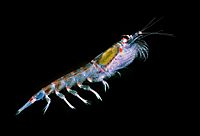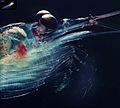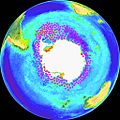Antarctic krill facts for kids
Quick facts for kids Antarctic krill |
|
|---|---|
 |
|
| Scientific classification | |
| Kingdom: | |
| Phylum: | |
| Subphylum: | |
| Class: | |
| Order: | |
| Family: | |
| Genus: |
Euphausia
|
| Species: |
E. superba
|
| Binomial name | |
| Euphausia superba Dana, 1850
|
|
Antarctic krill (Euphausia superba) is a species of krill that lives in the Antarctic waters of the Southern Ocean. They are shrimp-like and belong to the invertebrates.
They live in large groups, called swarms. Sometimes these swarms have a density of 10,000–30,000 individual animals per cubic meter.
They feed directly on very small phytoplankton, so they can use the energy that the phytoplankton originally got from the sun in order to sustain their life in the open ocean. They grow to a length of 6 cm, weigh up to 2 g, and can live for up to six years. They are a key species in the Antarctic ecosystem and are, in terms of biomass, probably the most successful animal species on the planet (approximately 500 million tonnes).
In aquaria, krill have been observed to eat each other.
- Hempel, G.: The krill-dominated pelagic system of the Southern Ocean. Envir. Inter. 13, pp. 33 – 36; 1987.
- Hempel, G.: Life in the Antarctic sea ice zone. Polar Record 27(162); pp. 249 – 253; 1991
- Hempel, G.; Sherman, K.: Large marine ecosystems of the world: trends in exploitation, protection, and research. Elsevier, Amsterdam: Large marine ecosystems 12, 423 pp; 2003
- Nicol, S. & de la Mare, W. K. Ecosystem management and the Antarctic krill. American Scientist 81 (No. 1), pp. 36–47. Biol 9:129–135; 1993.
- Nicol, S.; Foster, J.: Recent trends in the fishery for Antarctic krill, Aquat. Living Resour. 16, pp. 42 – 45; 2003.
- Sahrhage, D.: Antarctic Krill Fisheries: Potential Resources and Ecological Concerns. In Caddy, J. F. (ed.): Marine Invertebrate Fisheries; their assessment and management; pp. 13 – 33. Wiley, 1989.
- Ikeda, T. (1984) The influence of feeding on the metabolic activity of Antarctic krill (Euphausia superba Dana). Polar Biology 3(1)
- Clarke, A. (1983) Towards an energy budget for krill: The physiology and biochemistry of Euphausia superba Dana. Polar Biology 2(2)
Images for kids
-
The head of Antarctic krill. Observe the bioluminescent organ at the eyestalk and the nerves visible in the antennae, the gastric mill, the filtering net at the thoracopods and the rakes at the tips of the thoracopods.
-
Krill distribution on a NASA SeaWIFS image – the main concentrations are in the Scotia Sea at the Antarctic Peninsula
-
Annual world catch of E. superba, compiled from FAO data.
See also
 In Spanish: Kril antártico para niños
In Spanish: Kril antártico para niños









